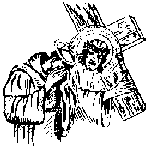THE ROMAN CATHOLIC CHURCH
Her Doctrine and Morals
The Seven Sorrows of The Blessed Virgin Mary
15 September 2024
![[Image]](ss.gif)
THE ROMAN CATHOLIC CHURCHHer Doctrine and MoralsThe Seven Sorrows of The Blessed Virgin Mary15 September 2024 |
The SundaySermon
|
Click the button on the right to be told about updates. Your address will be kept strictly private. |
Dear Friends in Christ,
Today is the former octave of the Nativity of the Blessed Virgin Mary. In the eleventh century, the sorrows of Our Lady were the object of private devotion. In the fourteenth century the moving "Stabat Mater" appeared, which a disputed tradition attributes to blessed Jacopone da Todi. In the seventeenth century, the Servites celebrated a solemn festival of the "Seven Sorrows of Our Lady," which was inserted in the general calendar of the Roman rite by Pope Pius VII in 1814 as a memorial of the sufferings of the Church in the person of her head upon earth in exile and captivity and of his deliverance through the Blessed Virgin's intercession. In 1912, Saint Pope Pius X fixed it on September 15, the former octave day of the Birthday of Our Lady.
We observe an ebb and flow of joys and sorrows in Mary's life. Happiness cannot be fully experienced unless some sorrow precedes it. The greater or more intense the sorrow, the greater and more intense the subsequent joy seems to be. To better understand this, we should first consider Jesus Christ, the Son of God, and His sorrows and joys.
Jesus left the happiness of Heaven to come to this earth to redeem us and open up the gates of Heaven for us. His joy and happiness were sacrificed to embrace our humanity and the suffering of the just punishments that our sins deserve. For thirty-three years, He suffered the humiliation of being in human form on this earth, as well as all the pains and sorrows attached to this. The height of His sorrows is seen upon the Cross of Calvary.
Even in the midst of heavy sorrows, there is a sense of joy in bearing all of these things for the love of us. The happiness of the Resurrection and Ascension was made possible and even intensified because of the previous pain and sorrow. This profound truth is a testament to the transformative power of love. Love turns the pains, sorrows, and sacrifices into acts of joy and happiness. It is a joy to be able to bear a sorrow or burden for those whom we love. The greater burden, pain, or sorrow that we are willing to bear for another is truly the measure of our love. Jesus gives us the perfect example, and invites us to follow Him in self-denial and sacrifice for the love of Him so that we can experience true and eternal happiness in Heaven.
Mary, the perfect imitator of Jesus, demonstrated unparalleled courage and strength. Her love for God carried her through numerous intense sorrows — so many swords that pierced her heart. Love compelled Mary to follow Jesus on the way to Calvary. Love forced her to stand beneath the Cross the entire time. It was love that made her accompany the Body of Jesus to the tomb. Love caused the ache in her heart as she was forced to leave His Body there. Though these sorrows were intense, the joy that followed was even more so.
These sorrows and joys are so intimately connected that it is as if they are not even separate. The sweetest joy is often hidden in the middle of the greatest sorrow. There is frequently at least a kernel of sorrow in the greatest happiness. Jesus willingly laid down His life and found joy in doing this for us, even in the intense suffering and misery. Mary willingly followed, watched, and spiritually joined Jesus in His Sacrifice, and she, too, found happiness in seeing the Will of God being fulfilled — in seeing the debt of sin being paid — the gates of Heaven being opened for us.
Far from withdrawing from sorrow, pain, suffering, and sacrifice, Jesus and Mary willingly and lovingly embraced them. In this embrace, they also experienced the consolation of joy in fulfilling God's will.
Today's feast invites us to spiritually follow Mary through each and every one of these sorrows — to observe her and appreciate the love that accompanied her sorrows and then observe the fruit of this love and sacrifice in the subsequent joy that filled her heart. It is truly love that makes this all possible. The love of God for us made it possible for Jesus to become Man and suffer for us. The love of Mary for Jesus and us made it possible for her to follow and join Jesus in all His sorrows.
It is now time for us to learn and imitate this love. Let us lovingly follow Mary in her sorrows as she lovingly followed Jesus in His sorrows. This is the only way for us to truly obtain and enjoy the blessed happiness that awaits us in Heaven. This happiness is also given to us in a small measure here and now as a foretaste of what awaits us in eternity. Our lives, like the Blessed Virgin Mary's, are to be filled with the ebb and flow of sorrow and joy. Let us not fear this or shy away from it but rather embrace it for the love of God. Let us be motivated and committed to follow Mary's example.
May the Immaculate Heart of Mary inspire, guide, and protect us!
 |
|
Would you like to make a donation?
Or, just log onto PayPal.com, after signing in you can send your donation to us at: Friars@friarsminor.org .
Return to Menu.
Return to Homepage.